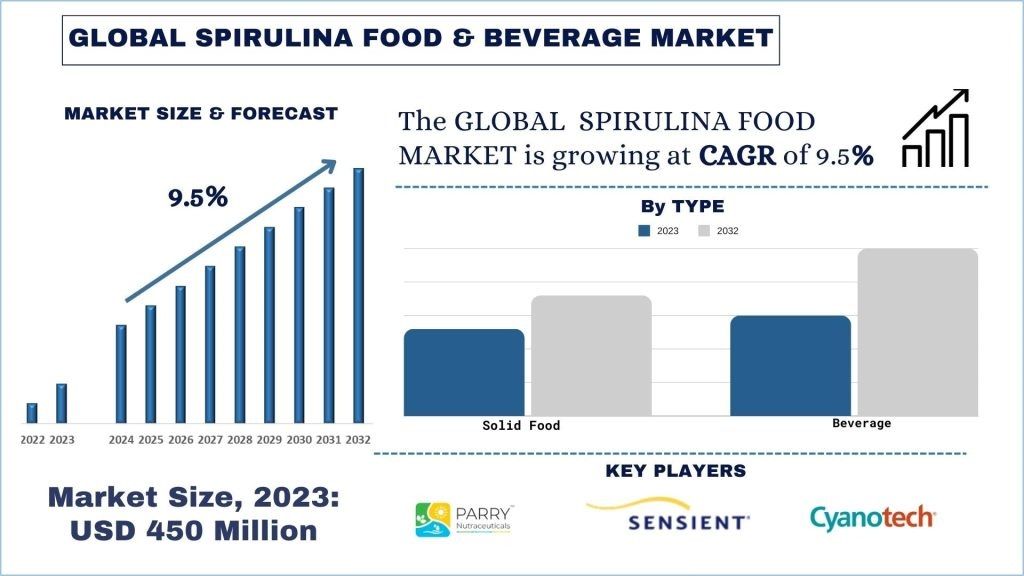
스피루리나 식품 & 음료 시장 규모 및 예측
스피루리나 식품 & 음료 시장은 약 4억 5천만 달러 규모로 평가되었으며, 식물성 단백질 보충제에 대한 수요 증가로 인해 예측 기간(2024-2032년) 동안 약 9.5%의 높은 연평균 성장률(CAGR)로 성장할 것으로 예상됩니다.
스피루리나 식품 & 음료 시장 분석
스피루리나 식품 & 음료 시장은 영양학적 이점과 건강을 중시하는 소비자 트렌드에 대한 인식이 높아짐에 따라 최근 몇 년 동안 꾸준히 성장해 왔습니다. 스피루리나 제품에 대한 수요는 높은 단백질 함량, 풍부한 영양 프로필, 면역 기능 강화 및 에너지 수준 향상과 같은 잠재적인 건강상의 이점으로 인해 증가했습니다. 스피루리나는 분말, 캡슐, 정제 등 다양한 형태로 제공되며 기능성 식품 및 음료의 성분으로도 사용됩니다. 더 많은 사람들이 천연 식물성 영양 공급원을 찾고 시장에 더 많은 제품이 출시됨에 따라 시장은 계속 확장될 것으로 예상됩니다. 현재 채식 위주 식단을 우선시하는 사람들이 늘면서 시장은 확대될 것으로 예상됩니다.
예를 들어, 2023년 8월 인도 하리아나 정부는 어린이 영양실조 퇴치를 위해 스피루리나 기반 제품을 도입한다고 발표했으며, 누(Nuh) 지역에서 6개월 시범 사업을 계획하고 있습니다.
게다가, 2022년 11월 GNT는 강황과 스피루리나로 만든 새로운 파우더를 사용하여 녹색 EXBERRY Coloring Foods의 범위를 확장했습니다. 이 파우더는 베이커리 믹스 및 조미료와 같은 건조하고 분말 형태의 제품에서 밝고 푸르스름한 녹색 음영을 제공하도록 설계되었습니다.
또한, 2021년 12월, Ful은 영국에서 자체 브랜드의 무알코올 믹서 제품군을 출시했습니다. White Peach, Lemon & Ginger, Lime, & Mint 맛으로 구성된 Ful Spirulina Fizz 제품군의 각 병에는 박테리아 기반 영양 보충제인 스피루리나 제형이 포함되어 있습니다.
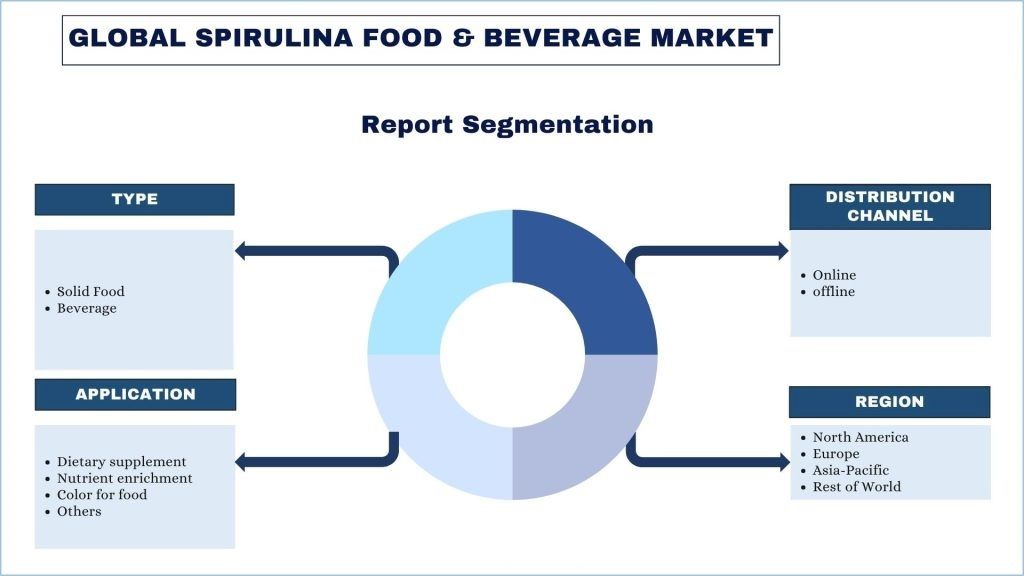
스피루리나 식품 & 음료 시장 동향
이 섹션에서는 당사 리서치 전문가 팀이 확인한 스피루리나 식품 & 음료 시장의 다양한 부문에 영향을 미치는 주요 시장 동향에 대해 논의합니다.
건강 보조 식품 부문, 산업 변화
스피루리나 식품 & 음료 시장의 건강 보조 식품 부문은 다양한 요인으로 인해 수년에 걸쳐 꾸준한 성장을 보였습니다. 건강 및 웰빙에 대한 인식이 높아짐에 따라 소비자들이 영양가 있는 옵션을 찾게 되었습니다. 영양이 풍부한 슈퍼푸드인 스피루리나는 높은 단백질 함량, 필수 비타민(예: B), 미네랄(예: 철분 및 마그네슘), 항산화제로 알려져 있습니다. 사람들이 더 건강한 식습관을 우선시함에 따라 스피루리나를 함유한 제품이 더욱 매력적으로 다가오고 있습니다. 식물성 식단의 증가와 지속 가능성에 대한 우려가 커지면서 소비자는 동물성 단백질이 높거나 환경에 미치는 영향이 큰 기존 스피루리나 식품의 대안을 적극적으로 찾고 있습니다. 청록색 조류의 일종인 스피루리나는 단백질 및 기타 영양소의 지속 가능한 공급원입니다. 스피루리나 재배는 기존 축산보다 더 적은 토지와 물을 필요로 하므로 친환경적입니다. 이 광범위한 소비자 기반은 스피루리나 시장에서 건강 보조 식품 부문의 전반적인 성장과 지속 가능성에 기여합니다. 이러한 추세가 식품 선호도에 계속 영향을 미침에 따라 스피루리나 기반 건강 보조 식품에 대한 수요가 더욱 확대되어 미래 시장 성장과 제품 혁신을 주도할 것입니다. 예를 들어, 2023년 11월, Nestlé Purina PetCare의 개 보충제 브랜드인 EverRoot는 은퇴한 프로 복서이자 웰빙 옹호자이자 LailaAliLifestyle.com 브랜드의 최고 경영자인 Laila Ali와 협력하여 브랜드 라인업을 위한 새로운 소프트 츄 보충제 포맷을 출시했습니다. 이 제품은 면역 건강을 지원하는 스피루리나, 소화를 지원하는 호박, 피부 건강을 지원하는 대구 간유로 만들어졌습니다.
북미, 예측 기간 동안 상당한 연평균 성장률(CAGR)로 성장할 것으로 예상
북미 내에서 미국은 시장의 주요 점유율을 차지하고 있습니다. 미국 시장 성장을 촉진하는 주요 요인은 이 지역의 급속한 도시화, 연구 개발 활동 증가, 투자 증가, 식물성 단백질 트렌드 증가, 혁신적인 제품 출시, 여러 시장 참여자입니다.
2023년 8월, 환경적으로 효율적인 기능성 영양의 새로운 카테고리를 창출하는 암스테르담 기반 식품 기술 스타트업인 FUL Foods는 최초의 제품인 자연적으로 활기찬 파란색 기능성 워터인 FULwater를 미국 시장에 출시했습니다. FUL Foods는 지구에서 가장 강력한 영양 공급원 중 하나인 스피루리나를 소비자 식품 및 음료를 위한 편리하고 맛있는 성분으로 전환하여 CO2를 재활용하는 획기적인 프로세스를 개발했습니다.
2022년 9월, DIC Corporation은 식용 청록색 조류인 스피루리나와 천연 파란색 식품 착색제인 LINABLUE를 생산하는 미국 자회사인 Earthrise와 중국 자회사인 Hainan DIC에 9백만 달러를 투자했습니다.
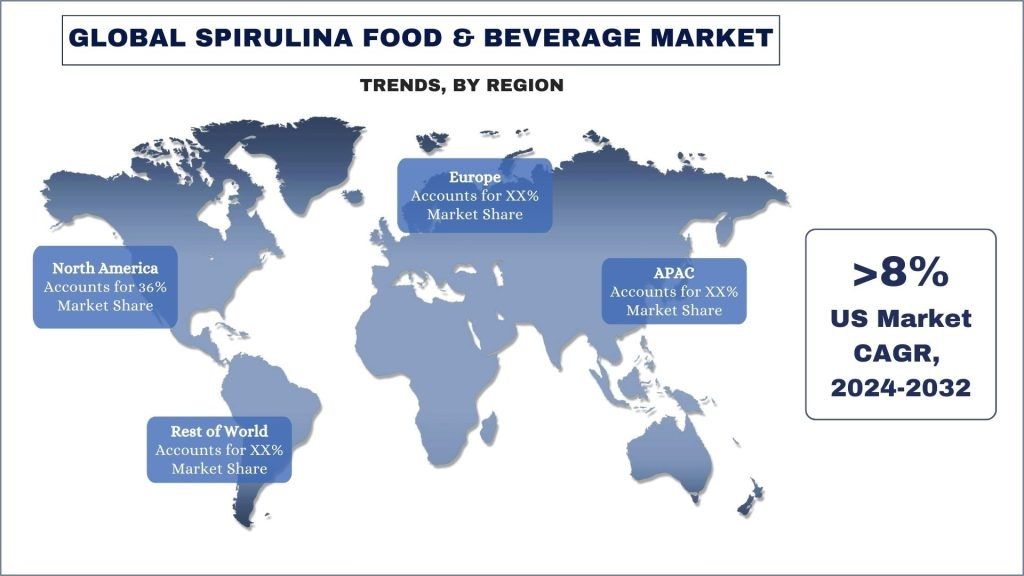
스피루리나 식품 & 음료 산업 개요
스피루리나 식품 & 음료 시장은 여러 글로벌 및 국제 시장 참여자가 존재하여 경쟁이 치열합니다. 주요 업체들은 파트너십, 계약, 협력, 새로운 유형 출시, 지리적 확장, 인수 합병 등 다양한 성장 전략을 채택하여 시장 입지를 강화하고 있습니다. 시장에서 활동하는 주요 업체로는 Aztec Spirulina, Prolgae Spirulina Supplies Pvt Ltd, BATA FOOD, Lee Biscuits, RKS Healthcare, TABÉRUMO CORPORATION, DIC CORPORATION, Cyanotech Corporation, Sensient Technologies Corporation, Parry Nutraceuticals Limited가 있습니다.
스피루리나 식품 & 음료 시장 뉴스
- 2023년 7월, 이스라엘 식품 기술 혁신 기업인 AlgaeCore Technologies의 SimpliiGood는 고단백 미세조류 성분인 스피루리나로 주로 구성된 닭고기 슈니첼 유사 제품을 출시했습니다.
- 2021년 8월, Prolgae는 인도 첸나이에서 100% 비건인 달콤한 스피루리나 파우더와 프로틴 바를 출시했습니다.
- 2021년 6월, 프랑스의 천연 원료 및 향료 공급업체인 Robertet와 미세조류 원료 생산업체인 Fleur de Vie는 공동으로 Spirulin Safe라는 고품질 스피루리나 원료를 출시했습니다.
스피루리나 식품 & 음료 시장 보고서 범위
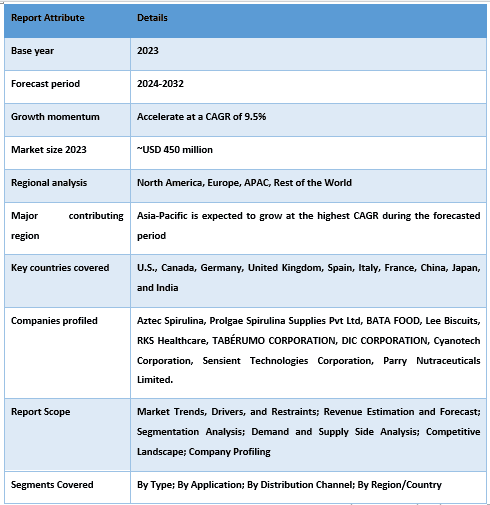
이 보고서를 구매해야 하는 이유:
- 이 연구에는 인증된 주요 산업 전문가가 검증한 시장 규모 측정 및 예측 분석이 포함되어 있습니다.
- 이 보고서는 전체 산업 성과에 대한 빠른 검토를 한눈에 제공합니다.
- 이 보고서는 주요 비즈니스 재무, 유형 포트폴리오, 확장 전략 및 최근 개발에 중점을 두고 주요 산업 동종 업체에 대한 심층 분석을 다룹니다.
- 산업에 널리 퍼져 있는 동인, 제약, 주요 동향 및 기회에 대한 자세한 검토.
- 이 연구는 다양한 부문에 걸쳐 시장을 포괄적으로 다룹니다.
- 산업에 대한 심층적인 지역 수준 분석.
맞춤화 옵션:
글로벌 스피루리나 식품 & 음료 시장은 요구 사항 또는 기타 시장 부문에 따라 추가로 맞춤화할 수 있습니다. 이 외에도 UMI는 귀하가 고유한 비즈니스 요구 사항을 가지고 있음을 이해하므로 귀하의 요구 사항에 완전히 맞는 보고서를 얻으려면 언제든지 문의해 주십시오.
목차
스피루리나 식품 & 음료 시장 분석(2024-2032)을 위한 연구 방법론
글로벌 스피루리나 식품 & 음료 시장의 과거 시장 분석, 현재 시장 추정, 미래 시장 예측은 주요 지역에서 스피루리나 식품 & 음료의 채택을 분석하고 평가하기 위해 수행된 세 가지 주요 단계였습니다. 과거 시장 수치를 수집하고 현재 시장 규모를 추정하기 위해 철저한 2차 연구가 수행되었습니다. 둘째, 이러한 통찰력을 검증하기 위해 수많은 결과와 가정을 고려했습니다. 또한, 글로벌 스피루리나 식품 & 음료 시장의 가치 사슬 전반에 걸쳐 업계 전문가들과 심층적인 1차 인터뷰도 진행했습니다. 1차 인터뷰를 통해 시장 수치에 대한 가정 및 검증 후, 전체 시장 규모를 예측하기 위해 하향식/상향식 접근 방식을 사용했습니다. 그 후, 시장 세분화 및 데이터 삼각 측량 방법을 채택하여 업계 관련 세그먼트 및 하위 세그먼트의 시장 규모를 추정하고 분석했습니다. 자세한 방법론은 아래에 설명되어 있습니다.
과거 시장 규모 분석
1단계: 2차 자료 심층 연구:
연례 보고서 및 재무 제표, 실적 발표, 보도 자료 등과 같은 회사 내부 자료와 저널, 뉴스 및 기사, 정부 간행물, 경쟁사 간행물, 섹터 보고서, 타사 데이터베이스 및 기타 신뢰할 수 있는 간행물을 포함한 외부 자료를 통해 스피루리나 식품 & 음료 시장의 과거 시장 규모를 파악하기 위해 자세한 2차 연구를 수행했습니다.
2단계: 시장 세분화:
스피루리나 식품 & 음료 시장의 과거 시장 규모를 파악한 후, 주요 지역의 다양한 세그먼트 및 하위 세그먼트에 대한 과거 시장 통찰력과 점유율을 수집하기 위해 자세한 2차 분석을 수행했습니다. 주요 세그먼트는 유형, 애플리케이션, 유통 채널 및 지역으로 보고서에 포함되어 있습니다. 해당 지역에서 테스팅 모델의 전반적인 채택을 평가하기 위해 추가 국가 수준 분석을 수행했습니다.
3단계: 요인 분석:
다양한 세그먼트 및 하위 세그먼트의 과거 시장 규모를 획득한 후, 스피루리나 식품 & 음료 시장의 현재 시장 규모를 추정하기 위해 자세한 요인 분석을 수행했습니다. 또한 스피루리나 식품 & 음료 시장의 유형, 애플리케이션, 유통 채널 및 지역과 같은 종속 변수와 독립 변수를 사용하여 요인 분석을 수행했습니다. 전 세계 스피루리나 식품 & 음료 시장 부문에서 상위 파트너십, 인수 합병, 사업 확장 및 유형 출시를 고려하여 수요 및 공급 측면 시나리오에 대한 철저한 분석을 수행했습니다.
현재 시장 규모 추정 및 예측
현재 시장 규모 산정: 위의 3단계에서 얻은 실행 가능한 통찰력을 바탕으로 현재 시장 규모, 글로벌 스피루리나 식품 & 음료 시장의 주요 업체 및 세그먼트의 시장 점유율에 도달했습니다. 필요한 모든 백분율 점유율 분할 및 시장 세분화는 위에서 언급한 2차 접근 방식을 사용하여 결정되었으며 1차 인터뷰를 통해 검증되었습니다.
추정 및 예측: 시장 추정 및 예측을 위해 이해 관계자에게 제공되는 동인 및 추세, 제약 및 기회를 포함한 다양한 요인에 가중치를 부여했습니다. 이러한 요인을 분석한 후, 관련 예측 기법, 즉 하향식/상향식 접근 방식을 적용하여 전 세계 주요 시장에서 다양한 세그먼트 및 하위 세그먼트에 대한 2030년 시장 예측에 도달했습니다. 시장 규모를 추정하기 위해 채택된 연구 방법론은 다음을 포함합니다.
- 수익(USD) 측면에서 업계의 시장 규모와 국내 주요 시장에서 스피루리나 식품 & 음료 시장의 채택률
- 시장 세그먼트 및 하위 세그먼트의 모든 백분율 점유율, 분할 및 세분화
- 제공되는 유형 측면에서 글로벌 스피루리나 식품 & 음료 시장의 주요 업체. 또한 빠르게 성장하는 시장에서 경쟁하기 위해 이러한 업체가 채택한 성장 전략
시장 규모 및 점유율 검증
1차 연구: 주요 지역의 최고 경영진(CXO/VP, 영업 책임자, 마케팅 책임자, 운영 책임자, 지역 책임자, 국가 책임자 등)을 포함한 핵심 오피니언 리더(KOL)와 심층 인터뷰를 실시했습니다. 그런 다음 1차 연구 결과를 요약하고 통계 분석을 수행하여 명시된 가설을 증명했습니다. 1차 연구의 입력 내용은 2차 연구 결과와 통합되어 정보를 실행 가능한 통찰력으로 전환했습니다.
다양한 지역에서 1차 참가자 분할
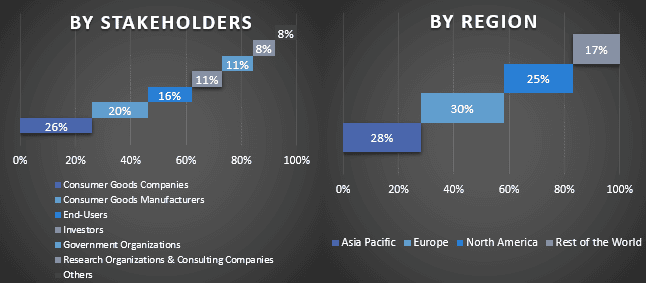
시장 엔지니어링
글로벌 스피루리나 식품 & 음료 시장의 각 세그먼트 및 하위 세그먼트에 대한 정확한 통계 수치를 도출하고 전체 시장 추정을 완료하기 위해 데이터 삼각 측량 기법을 사용했습니다. 유형, 애플리케이션, 유통 채널 및 글로벌 스피루리나 식품 & 음료 시장 지역에서 다양한 매개변수와 추세를 연구한 후 데이터를 여러 세그먼트 및 하위 세그먼트로 분할했습니다.
글로벌 스피루리나 식품 & 음료 시장 연구의 주요 목표
글로벌 스피루리나 식품 & 음료 시장의 현재 및 미래 시장 동향이 연구에서 정확히 지적되었습니다. 투자자들은 연구에서 수행된 질적 및 양적 분석에 대한 재량권을 기반으로 전략적 통찰력을 얻을 수 있습니다. 현재 및 미래 시장 동향은 지역 수준에서 시장의 전반적인 매력을 결정하여 산업 참가자가 미개척 시장을 활용하여 선점자 이점을 누릴 수 있는 플랫폼을 제공했습니다. 연구의 다른 정량적 목표는 다음과 같습니다.
- 가치(USD) 측면에서 스피루리나 식품 & 음료 시장의 현재 및 예측 시장 규모를 분석합니다. 또한 다양한 세그먼트 및 하위 세그먼트의 현재 및 예측 시장 규모를 분석합니다.
- 연구의 세그먼트에는 유형, 애플리케이션, 유통 채널 및 지역 영역이 포함됩니다.
- 스피루리나 식품 & 음료에 대한 규제 프레임워크를 정의하고 분석합니다.
- 다양한 중개인의 존재와 관련된 가치 사슬을 분석하는 동시에 산업의 고객 및 경쟁사 행동을 분석합니다.
- 주요 지역에 대한 스피루리나 식품 & 음료 시장의 현재 및 예측 시장 규모를 분석합니다.
- 보고서에서 연구된 지역의 주요 국가에는 아시아 태평양, 유럽, 북미 및 기타 지역이 포함됩니다.
- 스피루리나 식품 & 음료 시장의 회사 프로필과 빠르게 성장하는 시장에서 생존하기 위해 시장 참여자가 채택한 성장 전략.
- 산업에 대한 심층적인 지역 수준 분석
자주 묻는 질문 자주 묻는 질문
Q1: 스피루리나 식품 및 음료 시장의 현재 시장 규모와 성장 잠재력은 어느 정도입니까?
Q2: 스피루리나 식품 & 음료 시장 성장의 주요 요인은 무엇입니까?
Q3: 유형별 스피루리나 식품 & 음료 시장에서 가장 큰 점유율을 차지하는 부문은 무엇입니까?
Q4: 스피루리나 식품 & 음료 시장의 떠오르는 기술과 트렌드는 무엇입니까?
Q5: 스피루리나 식품 및 음료 시장을 어느 지역이 지배할 것인가?
관련 보고서
이 상품을 구매한 고객님들도 함께 구매하신 상품










